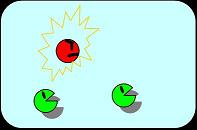Tokyo/Model
From 2007.igem.org
(Difference between revisions)
(→E.coli Follow Pareto's principle!) |
(→E.coli Follows Pareto's principle!) |
||
| Line 3: | Line 3: | ||
==E.coli Follows Pareto's principle! == | ==E.coli Follows Pareto's principle! == | ||
| - | ''' To follow Pareto’s principle like an [[Tokyo/Concepts|ant society]], our model system must follow the three conditions shown in Fig. 1 to 3. In our model, all | + | ''' To follow Pareto’s principle like an [[Tokyo/Concepts|ant society]], our model system must follow the three conditions shown in Fig. 1 to 3. In our model, all individual cells have the same genetic circuits but take two states, A (worker) and B (idler), depending on the surrounding circumstances.''' |
---- | ---- | ||
<br> | <br> | ||
| - | '''Condition 1. Bistable state''' | + | '''Bistable state ⇒ The removal of A (worker) ⇒ Regain of "stable coexistence''' |
| + | <br> | ||
| + | [[Image:model1.jpg|thumb|250px|'''Fig. 1 Condition 1. Bistable state''' <br>The system is stable when it contains both A (worker) and B (idler) at certain ratio.|left]] | ||
| - | [[Image: | + | [[Image:model2.jpg|thumb|250px|'''Fig. 2 Removal of A''' <br>By removal of A (worker), "stable coexistence" of the system is broken.|center|left]] |
| - | + | <!--Node B detects the removal of node A from the system and knows that there is only node B left.--> | |
| - | + | [[Image:model3.jpg|thumb|250px|'''Fig. 3 Condition 3. Regain of "stable coexistence"''' <br>Some B (idler) changes to A (worker) while the others remain B (idler). Then the system regains "stable coexistence".|center|left]] | |
| - | ''' | + | <br> |
| - | + | ||
| - | + | ||
| - | <br> | + | |
| - | + | ||
| - | '''Condition 3. Regain of "stable coexistence"''' | + | |
| - | + | ||
| - | + | ||
| - | <br> | + | |
<!--[[Image:concepts.jpg]]--> | <!--[[Image:concepts.jpg]]--> | ||
Revision as of 14:55, 25 October 2007
Abstract Concept & Model Requirements Genetic_circuit Works About_our_team
E.coli Follows Pareto's principle!
To follow Pareto’s principle like an ant society, our model system must follow the three conditions shown in Fig. 1 to 3. In our model, all individual cells have the same genetic circuits but take two states, A (worker) and B (idler), depending on the surrounding circumstances.
Bistable state ⇒ The removal of A (worker) ⇒ Regain of "stable coexistence


